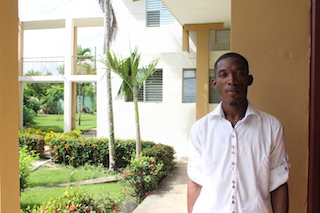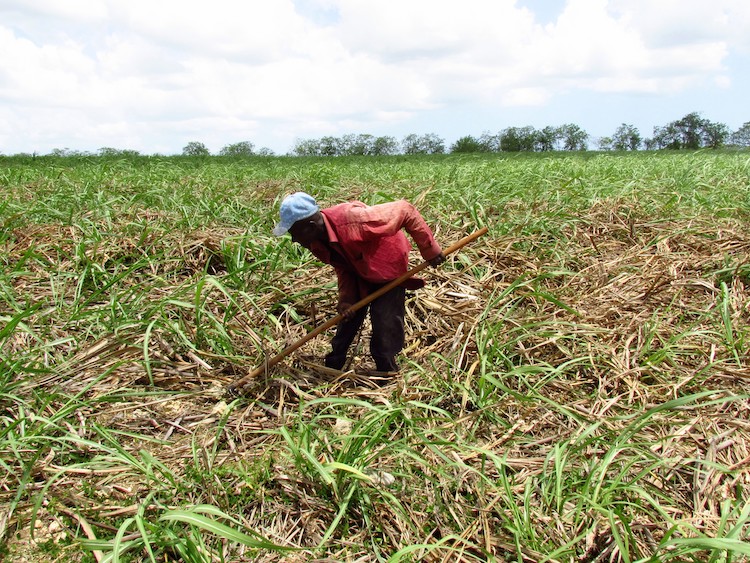My Dream and Passion

Pedro Luis Novas Firsen (1985) Batey Bombita, Barahona. Pedro is the father of two children, attends university and currently works as a substitute teacher in his community.
My dad chopped cane for the sugar mill. He got up at the crack of dawn and returned to the house at dusk because he didn’t want us to go hungry. He liked to drink rum, so he went to another batey called “Isabela.” Many times he was gone for up to five days without returning home, when he did he was drunk and broke.
When we had to go to school, we shared notebooks. For more than three years in a row, we wore the same school uniforms. If the notebooks still had clean pages, we kept using them because there was no money to purchase new ones. We attended classes, some under the shade of trees, some under bushes and, others, in two small classrooms that were shared at the same time with other teachers (due to lack of space), [and] there were not enough seats.
We used stones and pieces of [cinder] blocks as seats. We shared pencils or broke them into two or three pieces. We wore shoes, some of us the same pair, even when they were worn out - because there was no money.
In the houses, jars made of mud were used to conserve cold water, since there was no electricity and we did not have tanks to store the water; the children who finished the fourth grade had to go to another town to continue studying because the school did not go beyond 4th grade. I was lucky that, after finishing the third grade, I didn’t have to go to another town. Thank God and a man named Sebert Lane1 and the Reverend Connie DiLeo2 who came to our batey. Seeing the conditions in which we lived and studied, they became interested in building a school.
A few months later they appeared with a large group for the construction of the school (in 1996) that today is called Escuela COPA3 (Community Partners). There I finished my primary studies. Then I went to study at the Liceo Cruce de Palo Alto, about five kilometers from my house. Sometimes we couldn’t get a ride to go to high school, we would go any way we could, even on foot. Just like that, we went back home, walking. Many times, there was no food when we got home. When we would find food, it was the breakfast that had been prepared since early in the morning.
The construction of the school lasted less than a year. First, Mr. Sebert Lane and Reverend Connie DiLeo, sought help from some older people in the community to help them with the process to attain the deeds for the land and all the corresponding steps. They also sought the help of a school principal named Luciana Méndez who oversaw everything that had to be done. It has been 20 years since the school was built.
When the construction of this school began, I was 11 years old and I was in 2nd grade; this school has been a great blessing to us, in the Batey. Also for those in other nearby communities because they teach well there, every student has two sponsors who financially support the school and the annual activities for the children. Today I am studying at the Universidad Autonoma de Santo Domingo (UASD). I am in the 8th semester of Mathematical Education. Although I have not yet been able to finish the degree, I know that I will soon finish and graduate. I have not been able to finish yet because of the lack of resources, but I make the effort, although I’m taking only a few classes each semester, I still do it.
I have two children, a 3 year-old and the other one an 8 month-old baby. They are my passion, for them I wake up every day, looking for what I can do so that they have everything they need. I don’t want to see them go through what I went through when I was a child. I work as a substitute teacher in the very same school I saw built 20 years ago. I feel very proud to have studied there and have the privilege of working with my childhood teachers.
I am determined to continue my studies. What I earn at the school is not much, but it helps me with the university and with the children. There is no fixed rate. Sometimes I get paid RD2,000, sometimes RD3,000 and sometimes RD1,500, but I keep fighting for my children who are the ones who give me the strength to not stop and continue, every day, with what I do and what inspires me, which is teaching.

-
Sebert and Doreen Lane visited the Dominican Republic in 1991. When they saw the extreme poverty of the bateyes La Hoya and Bombita, in Barahona, and the difficulties to access quality education, they founded COPA, Community Partners Association. For more information, visit COPA’s website. ↩︎
-
Rev. Connie L. DiLeo is a missionary of the General Board of the GLobal Ministries of the United Methodist Church assigned to the Dominican REpublic. For more information, visit the UMC website. ↩︎
-
Community Partners Association (COPA) began their work in support of education in 1991 in Batey La Hoya, and in 1996 in Batey Bombita. COPA constructed schools in both communities and provides material resources so that students in the community can go to school. For more information, visit COPA’s website. ↩︎